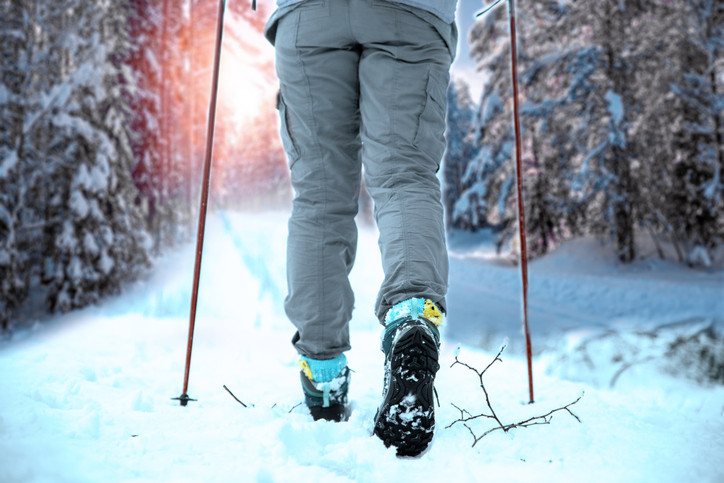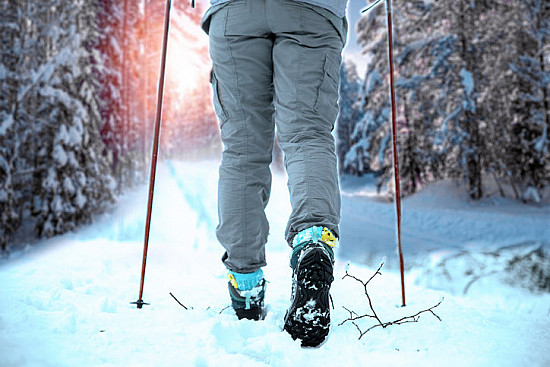
By midwinter, our urge to hibernate can start to essentially really feel constricting as an alternative of cozy. What larger antidote to being cooped up indoors than a bracing hike inside the crisp air outside?
Winter backdrops are stark, serene, and generally lovely. With fewer people on the trail, you possibly can spot additional creatures out and about. And it’s a prime various to interact with the seasons and our residing planet spherical us, says Dr. Stuart Harris, chief of the Division of Wilderness Medicine at Massachusetts Regular Hospital. Nevertheless a multi-mile trek by the use of powerful, frosty terrain is far completely completely different than warm-weather mountaineering, requiring consideration of nicely being and safety, he notes. That is what to know sooner than you go.
Winter mountaineering: Safety first
“The issue of mountaineering when environmental circumstances are considerably additional demanding requires a very completely completely different methodology on a winter’s day versus a summer season’s day,” Dr. Harris says. “However it affords us a possibility to be immersed inside the residing world spherical us. It’s our historic heritage.”
A security-first angle could be very important for many who’re mountaineering with others of assorted ages and expertise — say, with older relations or infants. It’s important to have every the right gear and the right mindset to make it nice and safe for all involved.
Planning and preparation for winter hikes
Put collectively correctly beforehand, significantly for many who’re mixing people with vastly completely completely different well being ranges. Plan your route fastidiously, reasonably than merely winging it.
Of us on the extremes of age — the very earlier or very youthful — are most inclined to frigid temperatures, and cold-weather mountaineering could also be additional taxing on the physique. “Winter circumstances could also be additional demanding on the middle than a perfectly-temperatured day,” Harris says. “Take heed to the bodily capabilities of everyone in your group, letting this define the place you go. It’s purported to be fulfilling, not a punishing train.”
Sooner than setting out:
- Understand how far, extreme, and distant you’ll go, Dr. Harris advises, and study the forecast for the world the place you may be mountaineering, taking wind chill and tempo into consideration. Notably at better altitudes, local weather can change from hour to hour, so preserve abreast of expectations for temperature ranges and any precipitation.
- Know for many who’ll have entry to emergency cell safety if one thing goes flawed.
- Always share plans with anyone not in your hike, along with anticipated route and time you’ll return. Fill out trailhead registers so park rangers may even know you’re on the trail in case of emergency.
What to placed on for winter hikes
Put collectively for extremes of chilly, wind, snow, and even rain to steer clear of frostbite or hypothermia, when physique temperature drops dangerously low.
- Costume in layers. Quite a few skinny layers of garments are larger than one thick one. Peel off a layer when you’re feeling warmth in extreme photo voltaic and add it once more when in shadow. Ideally, placed on a base layer comprised of wicking materials which will draw sweat away from the pores and pores and skin, adopted by layers that insulate and defend from wind and moisture. “As they’re saying, there isn’t a unhealthy local weather, merely inappropriate garments,” Dr. Harris says. “Take a day pack or rucksack and throw just a few additional thermal layers in. I on no account head out for any hike with out some means to change as a result of the local weather modifications.”
- Defend head, fingers, and toes. Placed on a wool hat, a thick pair of gloves or mittens, and two pairs of socks. Carry dry spares. Your boots have to be waterproof and have a rugged, grippy sole.
- Placed on sunscreen. You presumably can nonetheless get a sunburn in winter, significantly in places the place the photo voltaic’s glare shows off the snow.
Carry requirements to help assure safety
- Additional meals and water. Climbing inside the chilly takes important energy, burning many additional power than the an identical train completed in summer season temperatures. Pack nutrient-dense snacks equal to path mix and granola bars, which often combine nuts, dried fruit, and oats to supply wished protein, fat, and power. Additionally it is key to stay hydrated to take care of your core temperature common. Bonus elements for bringing a warmth drink in a thermos to warmth your core for many who’re chilled.
- First help bundle. Bandages for slips or scrapes on the trail and heat-reflecting blankets to cowl anyone exhibiting indicators of hypothermia are sensible. Even in above-freezing temperatures, hypothermia is possible. Look forward to indicators equal to shivering, confusion, exhaustion, or slurring phrases, and search quick help.
- Gentle provide. Time your hike so you aren’t on the trail in darkness. Nevertheless ship a lightweight provide in case you get caught. “A flashlight or headlamp is pretty darn useful for many who’re mountaineering wherever near the edges of daylight,” Harris says.
- Cellphone, map, compass, or GPS gadget plus additional batteries. Don’t rely in your phone for GPS monitoring, nevertheless completely value it in case you need to attain anyone shortly. “Simply make certain you will have the know-how and expertise set to have the power to navigate on- or off-trail,” Harris says, “and that you’ve got a technique of outside communication, significantly for many who’re in a giant, mixed group.”
